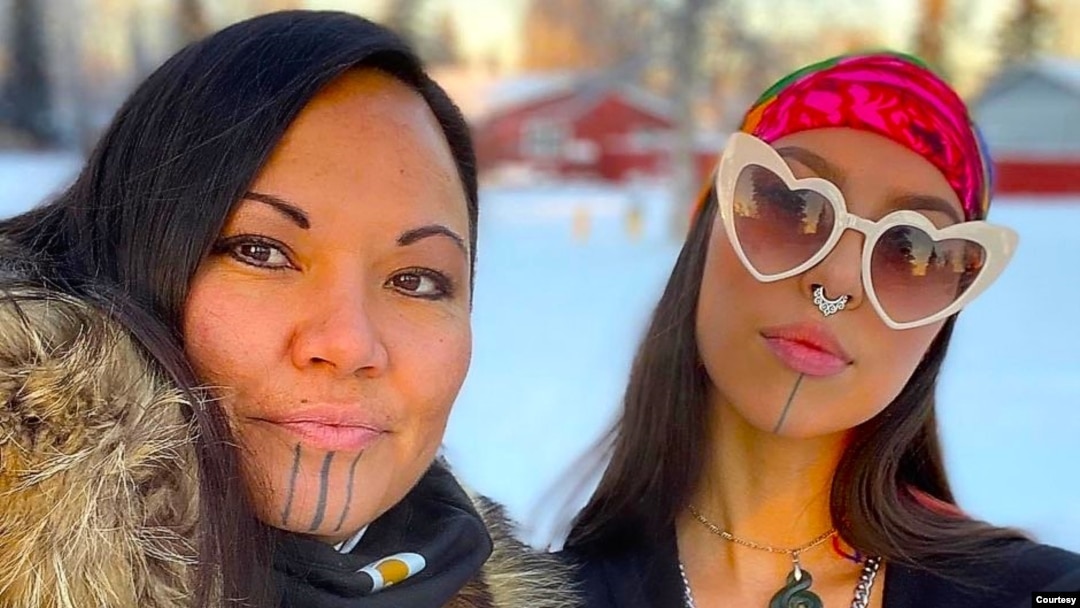For thousands of years, tattooing was an important form of cultural expression for Indigenous people across the Americas, but missionaries abolished the practice at different points in time as part of efforts to assimilate tribes and convert them to Christianity.
Today, a growing number of Native American, Alaska Native and Native Hawaiians are reviving tattooing, using methods their ancestors developed millennia ago.
Jody Potts-Joseph was born and raised in the Yukon River village of Eagle, home of the Athabascan-speaking Han Gwich’in people.
“I was raised pretty old school on the land and learned our traditional way of life, hunting and fishing for subsistence,” she said. “I was 18 when I learned that historically, Gwich’in men and women got tattooed — men on their joints and wrists, and women on their faces — as a rite of passage.”
For years, Potts-Joseph wanted to have her chin marked, but the last Gwich’in tattoo artists had passed away. Her daughter, Quannah Chasinghorse, also wanted a tattoo.
“She was only 12 at the time, and I told her to wait,” Potts-Joseph said. “I wanted to make sure that she was in an emotional space where she could handle any possible criticism or backlash.”
After two years of praying on it, Potts-Joseph relented. Using a large ink-dipped sewing needle, she gave her daughter what are called Yidiiltoo — lines at her eyes and on her chin. Soon afterward, Potts-Joseph enlisted her then-16-year-old son Izzy to ink her chin.
“For me, it was a reclaiming of my identity and part of my resistance to the shaming of our people after colonization,” she said. “And I saw my daughter change — she came into her power. She found her voice. Tattooing is powerful medicine.”
Markers of identity, spirituality, rank
Cultural anthropologist Lars Krutak, author of “Tattoo Traditions of Native North America,” has studied the traditions in 30 countries.
As a University of Alaska Fairbanks graduate student, he spent time among Yupik elders living on St. Lawrence Island in the Bering Sea. Yupik skin-stitch their tattoos, threading fine strands of reindeer or whale sinew through a bone or steel needle, then passing the thread through pigment and stitching designs into the top layer of skin.
“Typically, they used soot or lampblack from a seal oil lamp or the bottom of a cooking pot, mix it with water or human urine,” he said, explaining that urine’s high ammonia content helped in the healing process. “Sometimes, graphite was mixed into the pigment because it was believed to have spirit-repelling properties.”

A Siberian Yupik woman skin stitching the face of a young woman, c. 1900. Photo by Russian ethnographer Vladimir Bogoras.
Traditional tattooing served many functions.
“For one, marks could identify an individual’s family, clan, tribe or society,” Krutak said.
The Tlingit, Haida and other Northwest coastal peoples, for example, wore hand-poked family crests as a sign of social status, lineage and relationships to natural and supernatural events.
“There were therapeutic tattoos that were applied to primary joints to relieve arthritis,” he said. “I’ve documented tribes from Borneo to Alaska to Papua New Guinea who tattoo joint marks.”
Tattoos often marked milestones and achievements, such as a young hunter’s first kill.
“In some tribes in the Plains, you could read a man’s achievements on the battlefield by the marks he wore,” Krutak said.
This c. 1860 Cabinet card photograph shows Olive Oatman, orphaned and raised by the Mojave, who tattooed her according to tribal custom.
Smithsonian anthropologists in the late 1880s reported that men of rank in the Omaha Tribe were given “honor marks,” charcoal tattoos applied with flint points bound to rattlesnake rattles.
A blind eye
Artist, writer and educator L. Frank Manriquez is descended from the Tongva and Acjachemen tribes of Southern California, which have seen a rebirth of traditional Indigenous tattooing.
“I’d thought about it for a long time,” Manriquez said. “For me, it was about the connection, a way to hold hands across time with my women ancestors.”
She was 40 years old when she got her first tattoo, from “a racist Chumash biker guy,” she said, laughing. He used a modern tattoo gun to ink parallel lines on her cheekbones.
Later, she had her chin tattooed with a traditional “triple 1” design. Later, Manriquez met Keone Nunes, who had studied traditional Polynesian tattooing in Samoa.
L. Frank Manriquez (L.) with Hawaiian tattoo master Keli'i Makua. Both wear a Makapō eye tattoo. Photo, courtesy L. Frank Manriquez
Nunes hand tapped Manriquez’s makapō, a black rectangle around her left eye — a design with roots in the Marquesas Islands of French Polynesia.
“Makapō literally means ‘blind,’” Manriquez said. “And what it means spiritually is that I can see what others cannot.”
Like Potts-Joseph in Alaska, Manriquez said tattoos have changed her life.
“Non-Native Californians started treating me as if I were wearing priest robes,” she said. “All of a sudden, I was something they could not understand. But Native Americans listen to me differently, treat me differently.”
Quannah Chasinghorse at a Metropolitan Museum of Art's Costume Institute benefit gala, Monday, Sept. 13, 2021, in New York.
‘Not a trend’
Tattooing, once considered the domain of sailors, inmates and carnival barkers, has gone mainstream in America. In January 2022, Rasmussen Reports found that half of all Americans under age 40 wore at least one tattoo, up from 38% in 2016.
Many non-Natives draw inspiration from — if not outright copy — traditional Indigenous tattoos, a fact that angers Potts-Joseph. Her daughter, Chasinghorse’s, modeling career exploded in 2020 after being featured in a Calvin Klein advertising campaign.
Since then, Chasinghorse has appeared on fashion runways, at galas on and magazine covers internationally. This has given her a platform to advocate for climate justice and Indigenous inclusion. But the exposure has come at a cost.
“I look on social media and I’m seeing non-Native men and women wearing Quannah’s exact markings,” Potts-Joseph said. “We are very much opposed to anyone outside of our culture wearing traditional tattoos.”


